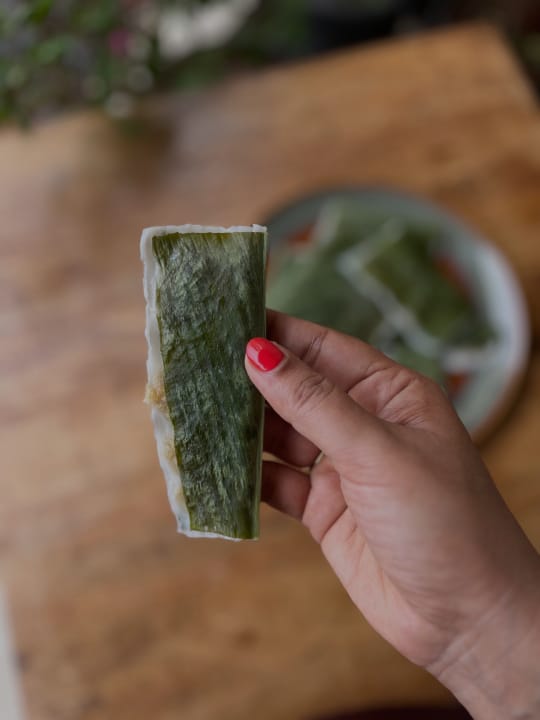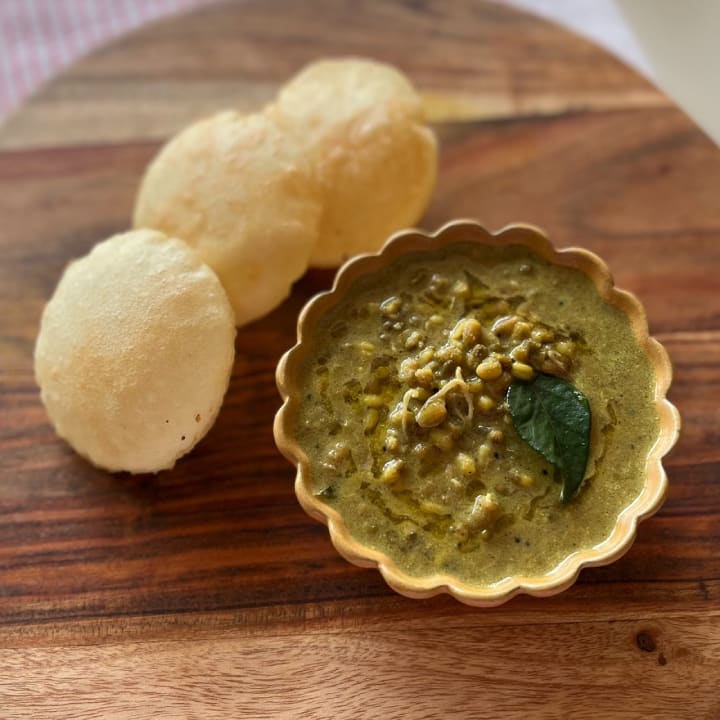



Patoleo, aptly described as a dish worthy of the divine, holds a sacred place during the first two days of Ganesh Chaturthi in the Gaud Saraswat Brahmin (GSB) community. The festivities commence with an offering to Goddess Parvati, who is believed to be pregnant, followed by a tribute to Lord Ganesh.
Gaud Saraswat cuisine is distinguished by its use of seasonal ingredients, and includes seafood and chicken dishes. Souring agents such as green mangoes in summer, ambade (hog plums) in monsoon and bimbli (Tree Sorrel) give the food a unique tang. The cuisine also showcases a variety of green leafy and root vegetables native to Goa, some growing wild around its lush forests, such as wild Amaranthus (kudduki bhaji) and Taro leaves (Arbi or Colocasia leaves).
The GSB community’s Ganesh Chaturthi food is superlative. Patoleo, the star of this celebration, is a labour of love. Turmeric leaves, abundant during monsoon, are lined with rice batter and filled with jaggery, ghee, coconut mix and, in some variations, cashews, before being steamed. This meticulous process ensures a fudgy sweet with a nuanced flavour profile.
“You only eat Patoleo during monsoons, and Goans wait for rains with as much restlessness as they wait for mangoes,” says Shubhra Shankhwalker, a home chef who founded Aai’s to host curated GSB meals at her ancient home within a farm. She also runs a home delivery business.
As you bite into this layered dessert, the sweetness from the jaggery and the nuttiness from the coconut intermingle (the cashews enhance both), infusing it with a coastal, tropical character.
The patoleo is served only the first day of the festival. While Goddess Parvati receives a simple version, without the lovely stuffing, paired with Panch Pale chi Bhaji, a vegetable dish made from five leafy greens, the devotees enjoy a patoleo with jaggery-coconut-cashew filling. “I cook the Panch Pale chi Bhaji with Moringa leaves, Tambdi bhaji (red spinach), Dudhyachi paana (the leaves of bottle gourd), and sometimes radish leaves, with a little salt.”
On other days, Lord Ganesh is served either Modak, a steamed sweet dumpling made from rice flour and khoya, stuffed with freshly grated coconut and jaggery, a tradition borrowed from neighbouring Maharashtra. “We offer Lord Ganesh 21 or 101 modaks, which are numbers considered auspicious,” adds Shubhra. Devotees also serve him Purnachyo nevryo (gujiya or sweet fried pastry) or Pais (which is like Payasam).
Throughout the festival, vegetarian dishes grace the menu, honouring Goa’s monsoon bounty of vegetables, leafy greens, and native ingredients. “Hing (asafetida) is an essential seasoning, adding depth to the cuisine,” says Shubhra. “Sticks of hing from a brand called Shankar Hing are roasted with ghee, ground to a fine powder and stored. In my cooking, sea salt adds complex flavours to the dishes.”

Notable offerings include Ambadyachi Karam, a chutney made from hog plums, hing, coconut and jaggery to give it a sweet-and-sour flavour profile. Native to the West Indies and introduced by the Portuguese to Goa, hog plums resemble an unripe mango but with little flesh.
Karela Raita (bitter gourd raita), a unique dish, is technically not a raita. Cashew paste forms the base, along with coconut and jaggery. Other specialties include Dudhiyachi Kade (vegetable made from buds of dudhi or bottle gourd), Alu or Taro chi bhaji (arbi or colacasia roots), Mirchi Wade (deep-fried mirchi pakoda), and Solkadhi, a spicy, tangy brew made from coconut milk, kokum and chillies).
 Patoleo
Patoleo
For the subtly spiced Varan Saar, tur dal or pigeon pea is cooked in two ways: with ghee and hing, or simmered with Ambadyachi Uddamethi (hog plums and a tempering of fenugreek or methi seeds and split black gram). “The hero ingredient here is the ginger,” says Shubhra.
Khatkhate, a divine vegetable stew, stands out with its 21 ingredients, including hog plum, seven-ridged bhindi or ladyfinger (native to Goa), pumpkin, yam, local cucumber (known as tashvem), and various leafy greens, simmered in coconut curry with moong dal, and spiced with chilli powder and turmeric. “Vegetables not native to Goa, such as carrots or beetroot are not used,” says Shubhra. “Corn adds depth and thickness to the flavourful concoction.”
 Made with sprouted mung beans, Mugachi Bhaji is eaten on the last day with wade or rice puris.
Made with sprouted mung beans, Mugachi Bhaji is eaten on the last day with wade or rice puris.
On the final day, Mugachi bhaji (sprouted moong dal with coconut) is enjoyed with wade (rice puris). “A lot of the vegetarian cuisine is slightly sweet as we add some jaggery or sugar to balance the flavours,” says Shubhra. The sweet platter includes Payas (or payasam) a fragrant dessert with jaggery, rice, sabudana and milk, topped with cinnamon, and Nevri (known as Gujiya in the north of India and Karanji in the west), a deep-fried pastry with wheat flour and coconut.
The cuisine’s complexity, heightened by spices such as clove, cinnamon, garlic and ginger, as well as souring agents such as tamarind, hog plums and mangoes, defies easy description. Spicy, tangy, sour and umami coalesce in a remarkable celebration of flavours.
More information
Besides the Ganesh Chaturthi meals, Shubra Shankhwalker hosts Saraswat Brahmin meals at her ancestral home in north Goa. You can book a meal through her Instagram handle. She hosts a minimum of four diners per meal.
Patoleo is sold in several stores and bakeries across Goa. Before buying it, do some research to check for the ones being recommended, and ensure your Patoleo is warm and fudgy. In the wrong hands, Patoleo can taste leathery and cold.
Discover the latest Business News, Sensex, and Nifty updates. Obtain Personal Finance insights, tax queries, and expert opinions on Moneycontrol or download the Moneycontrol App to stay updated!